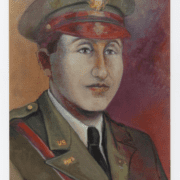Preserving the Legacy of Jewish American Veterans
by James LaPaglia, Digital Services Chief, National Cemetery Administration
Julien Saks (Dachau Liberator), Arnold Ascher (Berga Prisoner of War), Edwin Cornell (Bad Orb Prisoner of War), Leonard Domb (Berga Prisoner of War), Julius Bernstein (Landsberg Liberator), Meyer Lemberg (Berga Prisoner of War) – these are just a handful of thousands of Jewish Veterans interred in VA National Cemeteries and in VA-funded state, tribal, and territory Veteran cemeteries. All of them have stories — stories of their lives and their service to country, family, friends, and battle buddies.
More than 42,000 Jewish Veterans have interactive profile pages in the Veterans Legacy Memorial (VLM) (www.va.gov/remember) where family, friends, and others can see their military service and internment information, and upload tributes (comments), images, biographical information, career milestones, historical documents, and a word cloud.
Launched in 2019 by the National Cemetery Administration (NCA), individual veteran profile pages are populated with military service and cemetery information. This publicly available information is gathered from Department of Veterans Affairs records and includes service branch with logo, dates of birth and death, rank, war period, decorations, emblem of belief, and cemetery information. Currently more than 4.3 million veterans have VLM profile pages.
Colonel Julien David Saks was an attorney and realtor from Anniston, Alabama, who was commissioned as an Army reserve officer in December 1933 and entered active duty in September 1940. He attended Chemical Warfare School and the Command and General Staff College. When his 12th Armored Division arrived in France in November 1944, it quickly joined the final offensive push against German forces. His division crossed the Rhine River on March 28, 1945, and on April 27 captured the city of Landsberg in Bavaria. They liberated the Kaufering camp, the largest of eleven subcamps in the region comprising the Dachau concentration camp system. Here, thousands of prisoners, predominately Jewish, were used as slave labor to construct underground facilities to produce German fighter planes. Conditions at the camps were deplorable and mortality rates very high. As American forces approached, SS guards evacuated the inmates who could walk, sending them on forced death marches toward Dachau. Many who were unable to travel were brutally murdered and the bodies burned. Upon their arrival, the 12th Armored discovered some 500 dead prisoners. Saks, assigned to division HQ, visited two camps within hours of their discovery. He described the scene after. Fixated with shock upon seeing a building filled with burned corpses, he recalled, “I didn’t see a pile of naked women about three feet high behind me. I was told about it later. We were combat troops used to death and destruction, but this was so shocking that we were speechless.” Saks was awarded the Bronze Star for meritorious service in Europe and returned to Alabama after the war. He died in Houston, Texas, in 1993 and is interred in Houston National Cemetery – his VLM page is available at https://www.vlm.cem.va.gov/JULIENDAVIDSAKS/1780C94.
NCA plans to continue adding additional cemeteries to VLM in the coming years, including military and other government-run cemeteries and private cemeteries. Eventually NCA hopes to have a page for all deceased veterans, including those buried at sea or who are otherwise not interred in a cemetery.
You can search for a veteran by entering their first and last names, plus any additional identifying information such as cemetery location, service branch, war period, date of birth, date of death, or decoration. To submit items to a veteran’s page, users provide a name and email address, and then upload the content. All content is reviewed by moderators before posting to ensure VLM remains a respectful digital cemetery experience. To date more than 26,000 items have been posted to veteran pages.
Volume 75. Number 4. 2021




